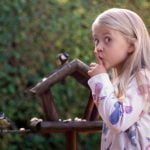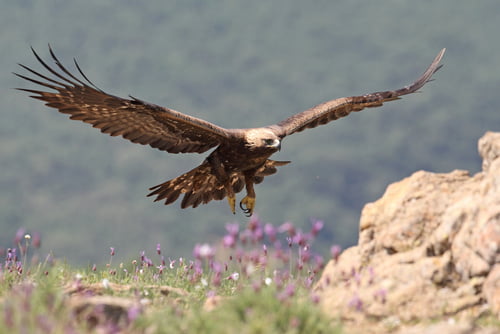
What is the current state of the UK’s wild bird populations?
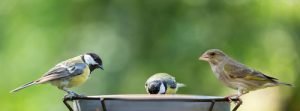
Image credit: Nitr/Shutterstock.com
Are UK bird populations in decline? For the overall bird population, the answer would appear to be most definitely ‘Yes’. However, according to the Government, it’s been a slow, steady decline, rather than the drastic event we might imagine.
The 2018 report by the Department for Environment, Food, and Rural Affairs (DEFRA) was entitled ‘Wild Bird Populations in the UK, 1970 to 2017’. It declared that the overall relative decline in wild bird numbers over the period was just 7%. The report was co-authored with the British Trust for Ornithology (BTO), the Joint Nature Conservation Committee (JNCC), the Wildfowl and Wetlands Trust (WWT), and the Royal Society for the Protection of Birds (RSPB).
The report cites a gradual decline but this is not the full picture. There is considerable flux within the populations of many bird species which is not obvious. In the last 50 years, there has been a serious, countrywide, decline in the number of many birds. These include many well-known and once-ubiquitous species, including song thrush, starling, skylark, lapwing, and tree sparrow. Conversely, numbers of some already common birds, e.g. wood pigeon, jackdaw, and goldfinch, have grown significantly in the same period.
The Latest Major Study
Trends in bird populations are used by interested organisations to assess the effects of environmental management on bird populations. These trends are then used to assess the effectiveness of the mitigation measures introduced to address the declines. Additionally, bird studies can also give a good indication of general wildlife trends.
The 2018 DEFRA Report cites a 7% loss in the status of native breeding bird species 0ver the last 50 years. This seems to be at odds with recent reports in the media of more than 40 million birds lost in the same period. The fact that surveys are relative means that all species are treated equally whatever their abundance. This has the effect of ensuring that declines in rare species are not over-shadowed by increases in common species.
While there has been a net loss of over 40 million birds in the last 50 years, the overall loss is estimated at 90 million. This number includes some 25 million starlings and around 20 million house sparrows. Populations that have gained, include some 8 million wrens and 7 million woodpigeons.
Overview of the DEFRA Report
In 2018, the DEFRA Report commented on population trends of 130 of the UK’s most copious breeding species. Most birds were consigned to one of four categories determined by their usual habitat. Thus, they were classed as either farmland birds, woodland birds, water and wetland birds, or seabirds. A fifth category was created for those birds that don’t readily fit any of the other four. These birds tend to frequent urban areas, heathlands, uplands, and coastal environments. Bird species with less than 500 nesting pairs in the UK were not included in the study.
It’s alluded to be impractical, due to the scope for significant error, to determine the changes in the actual individual bird populations over a given period for such a large sample set. Therefore, it’s the relative change in bird populations that were recorded, based on multiple counts of representative samples, rather than the actual change in numbers. This method of assessment is obviously not infallible but given the complexity of the undertaking, it was deemed to be the least-worst system.
The majority of the declining bird species in the UK are farmland birds. The DEFRA report indicated that between 1970 and 2017, the overall number of farmland birds declined by 56%. However, since 1986, woodland birds have also declined by 24%, and seabird populations by 20%. Both water and wetland bird populations have reportedly remained stable since 1975. However, winter waterbird populations are estimated to have grown by 98% in the same period.
Reasons for Declining Populations
Some woodland species such as the blue tit, chaffinch, and jays, appear to be holding their own with regard to numbers. However, other woodland species such as the lesser spotted woodpecker now look to be in serious decline. Conversely, the greater spotted woodpecker has seen its numbers grow threefold in the same period. One significant difference between the species is that greater spotted woodpeckers are capable of living in much more diverse conditions than their smaller cousin.
Research shows that the decline in UK bird populations is primarily a result of changes in agricultural practise. These were largely due to the implementation of the EU’s common agricultural policies between the late 1970s and late 80s. This cause is rather than the much-heralded climate change, although that too has had significant impact.
The role of farming in population decline
The strive for ever greater efficiency in the farming sector during that period had the effect of shrinking the UK’s farmland bird numbers by some 35%. Some of the past and current farming practises which have reduced wild bird numbers include:
- Maximising the amount of available farmland and hence reducing bird habitat by the removal of hedgerows to create larger fields; decreasing the area of marginal strips; and drainage of swampy ground and wetland areas.
- Sowing of autumn cereal, resulting in little or no field fallow time, thus reducing feeding opportunities for certain bird species
- Switch from mixed to specialised farming, resulting in a loss of habitat diversity
- Increase in the use of agricultural chemicals, especially fertilisers and pesticides
- Increase in the efficiency of grain and animal feed storage, diminishing feeding opportunities for some birds
- Demolition of old farm buildings, and thus, reduction in suitable nesting sites
Species in decline
The decline of UK bird populations has not always followed the same pattern, as some species declined significantly during the 1980s, while others have seen their numbers reduce more radically in the last 10 years. However, the reasons for the decline are in most cases consistent with those causes mentioned herein. Some of the once common UK birds that have been the biggest losers in the population game between 1970 and 2017, as documented in the 2018 DEFRA Report are shown below.
The estimated decrease in populations relative to 1970 levels:
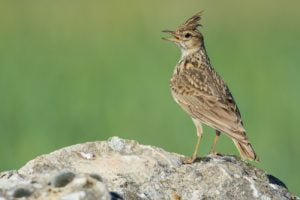
Skylark are 58% on 1970 populations. Image credit: J.M. Abarca/Shutterstock.com
- Corn bunting – down 89%
- Skylark – down 58%
- Snipe – down 80%
- Song thrush – down 56%
- Spotted flycatcher – down 85%
- Starling – down 81%
- Tree sparrow – down 90%
- Turtle dove – down 98%
- Willow tit – down 93%
- Yellow wagtail – down 97%
Currently Thriving Species
As mentioned, there has been a vast increase in the arrival of wintering waterbirds to the UK over the last 50 years. However, most bird species have declined in that period. However, there are other bird species that have bucked the trend and have subsequently thrived in the same period. The relative increase these bird populations is shown below.
Estimated increase in populations relative to 1970 levels:
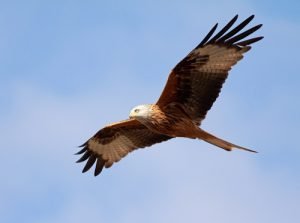
Red kites are up 406% on 1970 populations. Image credit: Binson Calfort/Shutterstock.com
- Blackcap – up 285%
- Buzzard – up 494%
- Cetti’s warbler – up 702%
- Goldfinch – up 176%
- Greater spotted woodpecker – up 346%
- Jackdaw – up 148%
- Mallard – up 210%
- Nuthatch – up 246%
- Peregrine Falcon – up 204%
- Red Kite – up 406%
- Woodpigeon – up 118%
Some reasons for thriving populations
Why have some bird species managed to thrive during the last 50 years, while a lot of species have seen severe declines in their numbers? Cetti’s warbler population increased more than sevenfold during the 48 years survey period. This warbler was first recorded in the UK as a nesting bird in 1973. It can be viewed as a prime example of the northward shift in the distribution of some species as a result of climate change.
Another reason for population increases is that there are now better protections for birds in place. This is probably accounted to a large degree for the big increase in the numbers of some birds of prey although, it is thought that the illegal killing of these birds is still fairly prevalent.
Changes to farming methods have been detrimental to most bird species but practices such as ploughing fields all year round, meaning that birds such as woodpigeons, now have greater feeding opportunities. Climate change has also knocked the once natural order of things out of sync to the disadvantage of some bird species. For instance, the hatching of certain insect species is now occurring earlier in the year due to the milder climate. This means that this potential food source is no longer available for fledgling birds of some species.
It would seem fairly obvious that those bird species that are currently thriving, are doing so, because they are simply more adaptable to change, and in particular climate change, than their declining counterparts.
The Outlook for UK Birds
There is almost unanimous agreement amongst the world’s leading experts that climate change effects will become increasingly severe through the course of this century. This is not only on the world’s biodiversity but on all of humanity. Thus, the emphasis of the 2018 DEFRA Report is on the considerable impact climate change will likely have on the UK’s future of bird populations.
Expert Predictions
Experts are predicting that the UK’s birdlife will continue to diversify, as new species will arrive in the country. Waterbirds, in particular, are predicted to continue the migration from continental Europe in greater numbers. This is because climate predictions are for greater change in Europe than in the UK. To help new species or greater populations of existing waterbirds colonise from Europe, large areas of new wetland will need to be developed. The Wallasea Island Wild Coast project is an example of such schemes.
However, one of the main obstacles to increasing bird colonisation is the limited availability of suitable habitats. For example, rising sea levels, combined with an expected increase in the severity of storms are expected to increase coastal flooding. This will result in the subsequent loss of intertidal, coastal freshwater, and brackish wetland habitats. Concerned authorities are now constantly monitoring changes to habitats brought on by climate change. They hope they will be able to introduce timely measures that mitigate the worst of these effects.
Current Practise
Current farming practises are now more friendly towards birdlife than previous methods. The causes of decline in bird numbers are also now beginning to be better understood. New policies and better management techniques should help to reverse the decades-long downward trend of bird populations. This should have a particular influence on farmland bird numbers, where devastation has been greatest.
The UK’s northern and upland birds are thought to be amongst the countries most vulnerable populations. Species such as dotterels, purple sandpipers, and whimbrels are breeding in the UK at the edge of their global range. Thus, these and other species have an inherently high risk of climate change-related extinction in the UK.
Some wetland species are recovering from past human-induced declines. It is thought these groups have the potential to establish, or re-establish, regular breeding populations in the UK. However, climate change-driven range shifts will need to be considered in establishing and managing the large areas of the new habitat that will be required, if bird populations are to recover to the number and diversity of the 1970s.
